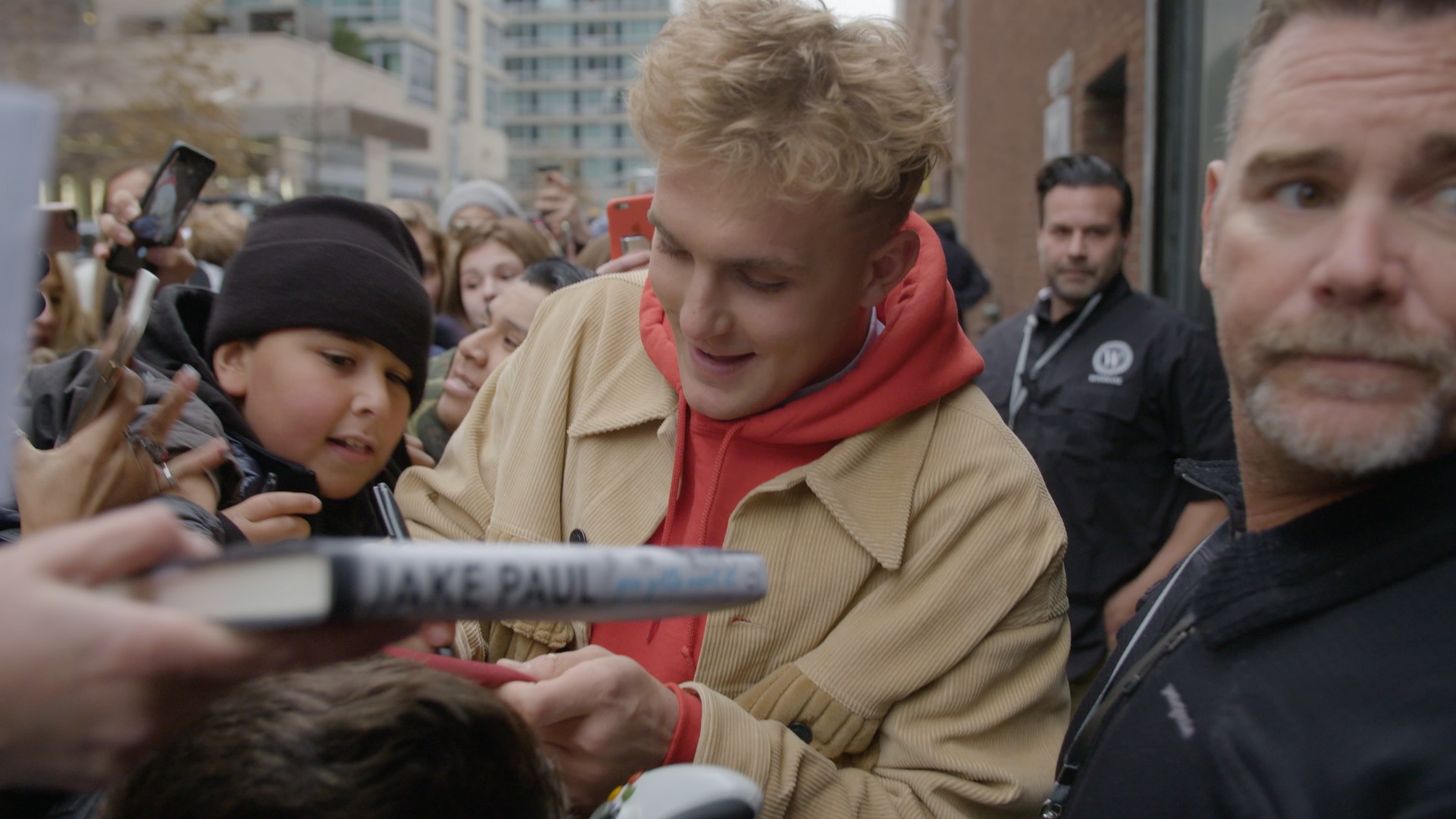YouTube
YouTube has become a beacon for anyone—especially anyone 25 years old and younger—to watch and obsess over content focusing on their favorite topics. Makeup? Check. Unboxing toys? Check. ASMR? You got it, ace. It’s easy to become obsessed with the seemingly mundane lives of others filming themselves ad nauseam, but when those others cross even the faintest of lines, it’s time to reassess the cultural ecosystem’s usefulness.Although YouTube has occasionally provided an outlet for young people to make their voices heard—especially when it comes to building like-minded communities for marginalized and underrepresented groups—YouTube stars like Alissa Violet, FaZe Banks, the Paul brothers, PewDiePie, and Jenna Marbles make ungodly amounts of money from posting digestible montages of their lives: Jackass-style stunts, Q&As with their best friends, footage of themselves completing “challenges,” and even just carrying around their iPhone X on a selfie stick to film their ultra-luxe day-to-day existence. The generation being molded on YouTube is one that is bound to reach its peak sooner or later, and the feeding frenzy of fandom only thrives as long as the object of a fan’s affection can provide. Which brings us to the current predicament of Logan Paul: An insanely popular YouTube star, Paul decided in the waning hours of 2017 that he’d post a video from his recent vacation in Tokyo, in which he and some friends apparently hired a local tour guide to take them through Aokigahara Forest.Paul claims that he and his friends wanted to explore the forest’s supernatural side, but the spot is primarily known as a place where people have gone to commit suicide. It is, without question, not the place you take your bros to go ghost-hunting. I can’t pretend to know Paul or what was going through his head that led him to all of this, but one thing is for sure: He and his crew stumbled upon a person who had apparently died by suicide. The Independent preserved parts of the now-deleted video (TW: suicide), in which you can see Paul’s horrified reaction to seeing the body of a deceased person.Despite this discovery and his reacting with horror at what he’d seen, Paul still chose to edit the video and post it to YouTube. He also promoted the video like he would for any other, showing a lack of compassion or decency that was truly chilling and led to two essentially insufficient apologies.Paul's since suffered even further serious consequences for his actions, too: He’s been removed from the popular YouTube Red show Foursome as well as the Google Preferred program (which will affect how brands advertise on his channel), and YouTube’s further put any projects with Paul on hold.And Paul's not the only YouTube star who has been massively followed and adored while going through deeply, deeply serious scandals. PewDiePie, one of the most popular and widely followed YouTubers, has previously tried to excuse using racist and anti-Semitic language during videos; earlier this week, popular YouTuber Shane Dawson faced allegations of pedophilia after an old podcast episode resurfaced where he was on record implying a six-year-old was “sexy”; and successful YouTuber DaddyOFive’s built a brand off playing “pranks” on his children that caused many to ask if his videos were more resembling child abuse than mere entertainment.Paul's arguably faced the most severe fallout in the immediate wake of his scandal, and YouTube’s past response to transgressions committed by their content creators has been mixed. In the fallout of PewDiePie’s racially charged comments, both his partnership with Disney-owned YouTube studio Maker and his YouTube reality show Scare PewDiePie were cancelled; YouTube has yet to issue an official response following Shane Dawson’s controversy; DaddyOFive lost custody of two of his children after he and his wife faced charges of neglect for a minor, but YouTube never issued an official response and the brand lives on through the MommyOFive and DaddyOFive channels.In general, YouTube’s culture doesn’t seem to receive proper policing from the service—if it does at all—until it’s too late. When the content associated with it stands against basic levels of societal decency that should be impressed upon young adults, we need to question if it should exist at all. Think of it this way: If someone showed you a dead body in real life, you would call the police, not hit “record.” Why not hold YouTubers to the same standard?Follow Allie Gemmill on Twitter.
Which brings us to the current predicament of Logan Paul: An insanely popular YouTube star, Paul decided in the waning hours of 2017 that he’d post a video from his recent vacation in Tokyo, in which he and some friends apparently hired a local tour guide to take them through Aokigahara Forest.Paul claims that he and his friends wanted to explore the forest’s supernatural side, but the spot is primarily known as a place where people have gone to commit suicide. It is, without question, not the place you take your bros to go ghost-hunting. I can’t pretend to know Paul or what was going through his head that led him to all of this, but one thing is for sure: He and his crew stumbled upon a person who had apparently died by suicide. The Independent preserved parts of the now-deleted video (TW: suicide), in which you can see Paul’s horrified reaction to seeing the body of a deceased person.Despite this discovery and his reacting with horror at what he’d seen, Paul still chose to edit the video and post it to YouTube. He also promoted the video like he would for any other, showing a lack of compassion or decency that was truly chilling and led to two essentially insufficient apologies.Paul's since suffered even further serious consequences for his actions, too: He’s been removed from the popular YouTube Red show Foursome as well as the Google Preferred program (which will affect how brands advertise on his channel), and YouTube’s further put any projects with Paul on hold.And Paul's not the only YouTube star who has been massively followed and adored while going through deeply, deeply serious scandals. PewDiePie, one of the most popular and widely followed YouTubers, has previously tried to excuse using racist and anti-Semitic language during videos; earlier this week, popular YouTuber Shane Dawson faced allegations of pedophilia after an old podcast episode resurfaced where he was on record implying a six-year-old was “sexy”; and successful YouTuber DaddyOFive’s built a brand off playing “pranks” on his children that caused many to ask if his videos were more resembling child abuse than mere entertainment.Paul's arguably faced the most severe fallout in the immediate wake of his scandal, and YouTube’s past response to transgressions committed by their content creators has been mixed. In the fallout of PewDiePie’s racially charged comments, both his partnership with Disney-owned YouTube studio Maker and his YouTube reality show Scare PewDiePie were cancelled; YouTube has yet to issue an official response following Shane Dawson’s controversy; DaddyOFive lost custody of two of his children after he and his wife faced charges of neglect for a minor, but YouTube never issued an official response and the brand lives on through the MommyOFive and DaddyOFive channels.In general, YouTube’s culture doesn’t seem to receive proper policing from the service—if it does at all—until it’s too late. When the content associated with it stands against basic levels of societal decency that should be impressed upon young adults, we need to question if it should exist at all. Think of it this way: If someone showed you a dead body in real life, you would call the police, not hit “record.” Why not hold YouTubers to the same standard?Follow Allie Gemmill on Twitter.
Advertisement

Advertisement
Paul’s behavior is unsurprising when you look at Paul’s previous, obnoxious antics. Starting out as a Vine star before moving to YouTube, Paul (as well as his brother Jake) made his millions performing stunts and engaging in crass antics to delight his legion of followers—or, his “Logang.” His recent “Why 2017 Was the Best Year Of My Life” video finds him recounting his numerous material blessings, including a $6.5 million mansion, a Rolex, and a car called “The Yeti.”Later in the Best of 2017 video, he recounts faking his own death, mailing his friend in a suitcase overseas, and getting in serious trouble with the Italian authorities after he and Jake tried to fly a drone over the Colosseum. So while it still remains to be seen how big a hit his career will take from his latest scandal, past evidence suggests that this type of behavior only makes people love him more. What reason does he have to stop?After days of relative silence on the issue, YouTube issued an official statement earlier this week that seemingly condemned Paul’s behavior. “Many of you have been frustrated with our lack of communication recently. You’re right to be. Suicide is not a joke, nor should it ever be a driving force for views. The channel violated our community guidelines, we acted accordingly, and we are looking at further consequences. It’s taken us a long time to respond, but we’ve been listening to everything you’ve been saying. We know that the actions of one creator can affect the entire community, so we’ll have more to share soon on steps we’re taking to ensure a video like this is never circulated again.”
Advertisement
